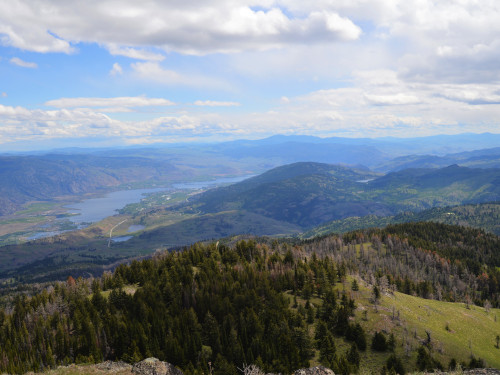SUBSCRIBE TO THE FREE NEWSLETTER
Hike British Columbia’s next national park!
Great news this week for the environment in British Columbia: the Canadian federal government, working with the BC provincial government and local First Nations, announced the start of a formal process to create a new national park reserve in BC’s South Okanagan and Similkameen valleys. You can read more about Tuesday’s announcement at Global News and The Globe & Mail.
Interested in seeing what the new, 273 square-km park will have to offer? Cascadia Magazine hiking columnist Craig Romano has a timely suggestion for a trail this week: Mount Kobau, which is the centerpiece of the proposed park. It’s set in a fascinating, dry ecosystem of pines and sagebrush and the trail to the summit is actually quite easy. The views from the top are fabulous, with a panorama of peaks in both BC and Washington to the south.
Explore what will be BC’s next wild gem by reading Craig’s article now online at Cascadia Magazine.
And for hiking suggestions all over Cascadia during the Canada Day / Fourth of July week & weekend, check out the Get Outside! hiking archive at Cascadia Magazine.
US Navy pollution in the Salish Sea
Cascadia Magazine is proud to publish an investigative feature by Seattle journalist John Stang looking at how the US Navy dumped tons of copper-laden paint and barnacles into Puget Sound. In 2017 the Navy scraped the hull of decommissioned aircraft carrier USS Independence, leaving the barnacles and paint chips at the bottom of Sinclair Inlet. Make time over the holiday week to read it.
Stang reports on the coalition of environmental groups, the Suquamish tribe, and the state of Washington–all of whom are suing the Navy to stop the practice and require it to clean up the polluted site at Puget Sound Naval Shipyard in Bremerton, Washington. Read the full article online at Cascadia Magazine. Thank you to the Fund for Investigative Journalism for providing a generous grant for this reporting.
Seattle has a plan (sort of) for people living in vehicles
The Seattle Times reports that a long-awaited safe parking lot for homeless people who live out of their vehicles has been scuttled because of neighborhood opposition– the new plan involves inviting various churches and religious organizations to host the sites. Meanwhile, the South Seattle Emerald looks at a conflict over who will manage a “Nicklesville” tiny house village in Seattle’s south end. And Portland’s Street Roots newspaper looks in-depth at US president Trump’s misguided threat to intercede in west coast cities’ homeless crisis–and what a disaster this administration’s cuts to federal housing funds have been for Portland. For more on the crisis in Seattle of people living in their vehicles, read this feature published last year at Cascadia Magazine.
Why is Oregon ignoring tsunami risk?
Kathryn Schulz, who terrified readers of the New Yorker several years ago with her report on how horrible a major Cascadia megaquake would be, has a new article about how Oregon seems intent on ignoring the risks from a megaquake tsunami. It focuses on a law passed recently in the Oregon legislature that will end a ban on building schools, hospitals, police stations, and other essential structures in the tsunami danger zone on the coast. OregonLive has more on the measure, and NW News Network looks at a school in Cannon Beach OR giving all students an earthquake preparedness kit.
Unknown health affects of fracking & LNG in British Columbia
The Narwhal looks at new reports questioning health effects of LNG production and the larger issue of why British Columbia seems to think LNG is a climate-friendly fuel. CBC looks in more depth as to why more scientists say natural gas is as bad as coal as a climate change contributor (while BC is currently construction a $40 billion export terminal and pipeline).
How are the mountain goats helicoptered out of the Olympics doing?
Last year, the National Park Service started a project to remove mountain goats from Washington’s Olympic National Park (they’re not native to the peninsula, and destroy fragile, endangered plants). The Seattle Times follows up on the removal by helicopter, and looks at whether the goats relocated to the Cascades have fared well.
Claudia Castro Luna on the trauma of immigration
Washington poet laureate Claudia Castro Luna writes an essay for the Seattle Times on the lifelong trauma that accompanied her family’s escape from war-torn El Salvador, and how we must have empathy for the children and adults now treated with cruelty in camps the US government has set up. “These days I cannot read stories of the children at the border in one sitting. My throat pinches closed, and I can’t breathe as my body floods with fear,” she writes.
New book an ode to the islands of the Salish Sea
Theresa Kishkan, writing for BC BookLook, has a detailed review of Love of the Salish Sea Islands, a collection of essays, memoirs, and poems about life on the islands in the Straight of Juan de Fuca, Puget Sound, and Georgia Straight. It sounds like a fascinating collection, covering everything from the earliest Indigenous inhabitants to contemporary residents, such as poet Mike Redican of Savary Island, who writes:
“each spring a little more is gone
a favourite arbutus
six sections of fence
thirteen steps leading down to the sea.” Read the review here.
And there you have today’s collection of arts, news, and culture from across the Cascadia bioregion. We’ll be taking a break for the US Independence Day holiday and return on Monday, July 8. Enjoy your weekend! –Andrew Engelson
Photo credits: view at the summit of Mount Kobau courtesy of Craig Romano

